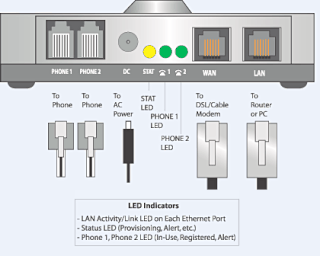The Session Initiation Protocol (SIP) is a signaling protocol used for initiating, maintaining, and terminating communication sessions that include voice, video and messaging applications. SIP is used in Internet telephony, in private IP telephone systems, as well as mobile phone calling over LTE (VoLTE).
Voice over Internet Protocol (VoIP), also called IP telephony, is a method and group of technologies for voice calls for the delivery of voice communication sessions over Internet Protocol (IP) networks, such as the Internet.
The Skinny Client Control Protocol (SCCP) is a proprietary network terminal control protocol originally developed by Selsius Systems, which was acquired by Cisco Systems in 1998.
STUN is a standardized set of methods, including a network protocol, for traversal of network address translator (NAT) gateways in applications of real-time voice, video, messaging, and other interactive communications.

Asterisk is a software implementation of a private branch exchange (PBX). In conjunction with suitable telephony hardware interfaces and network applications, Asterisk is used to establish and control telephone calls between telecommunication endpoints such as customary telephone sets, destinations on the public switched telephone network (PSTN) and devices or services on voice over Internet Protocol (VoIP) networks. Its name comes from the asterisk (*) symbol for a signal used in dual-tone multi-frequency (DTMF) dialing.

An analog telephone adapter (ATA) or FXS gateway is a device for connecting traditional analog telephones, fax machines, and similar customer-premises devices to a digital telephone system or a voice over IP telephone network.

A business telephone system is a telephone system typically used in business environments, encompassing the range of technology from the key telephone system (KTS) to the private branch exchange (PBX).
The IP Multimedia Subsystem or IP Multimedia Core Network Subsystem (IMS) is a standardised architectural framework for delivering IP multimedia services. Historically, mobile phones have provided voice call services over a circuit-switched-style network, rather than strictly over an IP packet-switched network. Various voice over IP technologies are available on smartphones; IMS provides a standard protocol across vendors.
PacketCable network is a technology specification defined by the industry consortium CableLabs for using Internet Protocol (IP) networks to deliver multimedia services, such as IP telephony, conferencing, and interactive gaming on a cable television infrastructure.
The next-generation network (NGN) is a body of key architectural changes in telecommunication core and access networks. The general idea behind the NGN is that one network transports all information and services by encapsulating these into IP packets, similar to those used on the Internet. NGNs are commonly built around the Internet Protocol, and therefore the term all IP is also sometimes used to describe the transformation of formerly telephone-centric networks toward NGN.
Zfone is software for secure voice communication over the Internet (VoIP), using the ZRTP protocol. It is created by Phil Zimmermann, the creator of the PGP encryption software. Zfone works on top of existing SIP- and RTP-programs, but should work with any SIP- and RTP-compliant VoIP-program.
Mobile VoIP or simply mVoIP is an extension of mobility to a voice over IP network. Two types of communication are generally supported: cordless telephones using DECT or PCS protocols for short range or campus communications where all base stations are linked into the same LAN, and wider area communications using 3G or 4G protocols.
Text over IP is a means of providing a real-time text (RTT) service that operates over IP-based networks. It complements Voice over IP (VoIP) and Video over IP.

H.323 is a recommendation from the ITU Telecommunication Standardization Sector (ITU-T) that defines the protocols to provide audio-visual communication sessions on any packet network. The H.323 standard addresses call signaling and control, multimedia transport and control, and bandwidth control for point-to-point and multi-point conferences.
An IP PBX is a system that connects telephone extensions to the public switched telephone network (PSTN) and provides internal communication for a business. An IP PBX is a PBX system with IP connectivity and may provide additional audio, video, or instant messaging communication utilizing the TCP/IP protocol stack.
Bridging Systems Interface is a standard protocol for communicating with physical interfaces which attach analog or digital voice radios to digital data networks—known as 'Radio over IP'--to make easier the use of remote radios by local users, and the sharing of radios by multiple users, in the service of improving emergency communications interoperability. The standard is promulgated by the SAFECOM program in the US Department of Homeland Security's Office for Interoperability and Compatibility, specifically, the VoIP Working Group.
SunComm Technology is a Taiwan multinational computer technology and GSM Voice over IP gateway manufacturer. The main products in 2010 focused on GSM VoIP gateways & IP surveillance camera devices. Core members have been engaging in the communication & networks industry since 1977.

The media gateway control protocol architecture is a methodology of providing telecommunication services using decomposed multimedia gateways for transmitting telephone calls between an Internet Protocol network and traditional analog facilities of the public switched telephone network (PSTN). The architecture was originally defined in RFC 2805 and has been used in several prominent voice over IP (VoIP) protocol implementations, such as the Media Gateway Control Protocol (MGCP) and Megaco (H.248), both successors to the obsolete Simple Gateway Control Protocol (SGCP).
A VoIP gateway is a gateway device that uses Internet Protocols to transmit and receive voice communications (VoIP).
WebRTC Gateway connects between WebRTC and an established VoIP technology such as SIP. WebRTC is an API definition drafted by the World Wide Web Consortium (W3C) that supports browser-to-browser applications for voice calling, video chat, and messaging without the need of either internal or external plugins.


![Yealink Network Technology Co Ltd [zh] T27G VoIP Telephone Yealink T27G.png](http://upload.wikimedia.org/wikipedia/commons/thumb/8/80/Yealink_T27G.png/220px-Yealink_T27G.png)





